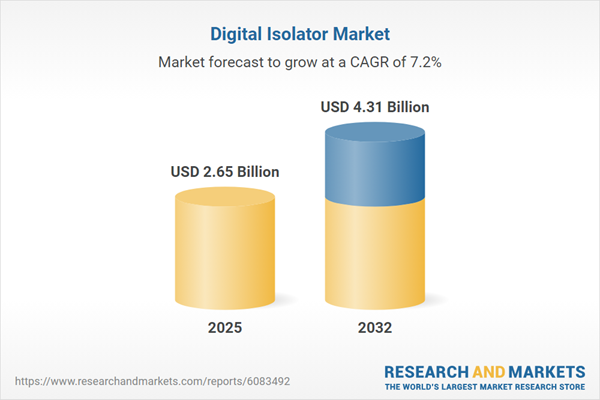Speak directly to the analyst to clarify any post sales queries you may have.
The digital isolator market is transforming how industries achieve safer, more reliable data transfer within critical electronic systems. As global electrification and automation efforts intensify, decision-makers are focused on robust components that meet the demands of modern architectures and evolving regulatory frameworks.
Market Snapshot: Digital Isolator Market Size, Growth, and Outlook
The Digital Isolator Market grew from USD 2.47 billion in 2024 to USD 2.65 billion in 2025. It is expected to continue growing at a CAGR of 7.18%, reaching USD 4.31 billion by 2032. This growth is propelled by advances in digital signal isolation, replacing traditional optocouplers with solid-state devices offering superior bandwidth, efficiency, and longevity. Expanding applications in automotive, industrial automation, medical, energy, and consumer electronics sectors underpin this trajectory, supported by stringent functional safety standards and distributed electronic system architectures.
Scope & Segmentation
- Channel Count: Single Channel, Dual Channel, Multiple Channel, Quad Channel
- Data Rate: High Speed, Low Speed
- Isolation Voltage: Below 1500 V, 1500 V To 5000 V, Above 5000 V
- Supply Mode: Bidirectional, Unidirectional
- Package Type: Surface Mount, Through Hole
- End User: Automotive, Consumer Electronics, Healthcare, Industrial Automation, Telecommunications
- Application: Aerospace & Defense, Automotive (ADAS, Electric Vehicles, Battery Management Systems, Drive Inverters, On-Board Chargers, Infotainment, Internal Combustion), Consumer Electronics, Energy & Power (Energy Storage, Power Supplies, Renewable Energy, Smart Grids), Industrial (Factory Automation, PLCs, Process Control, Robots & Automation, Collaborative Robots, Industrial Robots), Medical, Telecommunications
- Regional Coverage: Americas (North America, Latin America), Europe, Middle East & Africa, Asia-Pacific (China, India, Japan, South Korea, Australia, Indonesia, Thailand, Malaysia, Singapore, Taiwan)
- Leading Companies: Texas Instruments, Analog Devices, Broadcom, Silicon Laboratories, ON Semiconductor, Rohm, NXP Semiconductors, STMicroelectronics, Renesas Electronics, Infineon Technologies
Key Takeaways for Digital Isolator Market Decision-Makers
- Emerging technologies in semiconductor materials such as silicon carbide and gallium nitride have transformed isolation capabilities, fostering integration into smart sensors and power modules.
- Growing demands in automotive sectors, particularly for electric powertrains and driver assistance systems, are driving multi-channel and high-speed isolation device adoption for compliance and performance.
- Industrial automation increasingly favors multiple-channel and high-data-rate configurations to enhance throughput, simplify board design, and support IIoT rollouts.
- Wide segmentation by channel configuration, voltage classes, and packaging ensures device selection aligns closely to application-specific needs—whether for consumer, medical, grid, or automotive environments.
- Strategic investments in localized manufacturing, design partnerships, and end-to-end value chains enhance the resilience and responsiveness of global supply networks.
- Collaborative innovation among established leaders and specialized entrants accelerates the delivery of tailored solutions meeting evolving regulatory and technical requirements.
Tariff Impact and Supply Chain Resilience
New import tariffs introduced in 2025 have challenged digital isolator supply chains, especially for components sourced from Asian manufacturing centers. Manufacturers responded by diversifying procurement strategies, establishing local assembly operations, and enhancing partnerships with regional distributors. These adaptations are enhancing long-term resilience, while also advancing standardization in materials sourcing and customs documentation to streamline logistics and compliance internationally.
Methodology & Data Sources
This report draws from in-depth interviews with senior stakeholders in key end-use verticals, supportive secondary research including technical publications and regulatory documents, and robust validation processes. Insights were cross-checked using third-party databases and analytical approaches such as SWOT and value chain assessments to ensure rigorous, actionable intelligence.
Why This Report Matters
- Delivers actionable insights into technology and regulatory shifts, empowering senior leaders to shape future-ready product and sourcing strategies.
- Provides clear guidance for identifying risk mitigation opportunities, from dual sourcing models to regional manufacturing alignment.
- Enables selection of digital isolation technologies best suited for each end-market’s evolving requirements—supporting competitive, standards-compliant solutions globally.
Conclusion
Advances in digital isolation are redefining sector standards for reliability and safety. This report equips decision-makers with the clarity needed to navigate shifting dynamics and seize new market opportunities.
Table of Contents
3. Executive Summary
4. Market Overview
7. Cumulative Impact of Artificial Intelligence 2025
Companies Mentioned
The companies profiled in this Digital Isolator market report include:- Texas Instruments Incorporated
- Analog Devices, Inc.
- Broadcom Inc.
- Silicon Laboratories Inc.
- ON Semiconductor Corporation
- Rohm Co., Ltd.
- NXP Semiconductors N.V.
- STMicroelectronics N.V.
- Renesas Electronics Corporation
- Infineon Technologies AG
Table Information
| Report Attribute | Details |
|---|---|
| No. of Pages | 189 |
| Published | October 2025 |
| Forecast Period | 2025 - 2032 |
| Estimated Market Value ( USD | $ 2.65 Billion |
| Forecasted Market Value ( USD | $ 4.31 Billion |
| Compound Annual Growth Rate | 7.1% |
| Regions Covered | Global |
| No. of Companies Mentioned | 11 |









